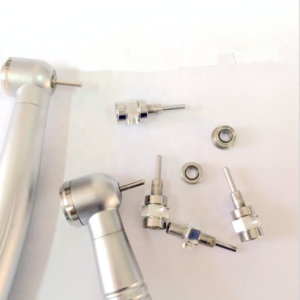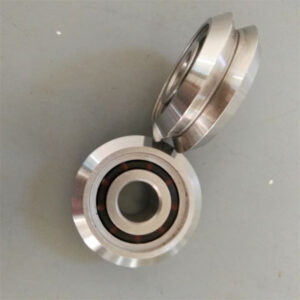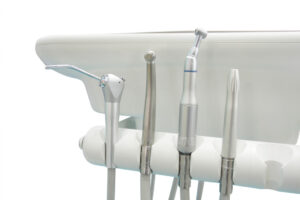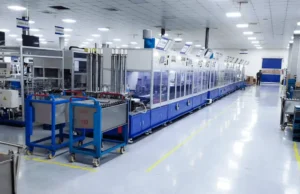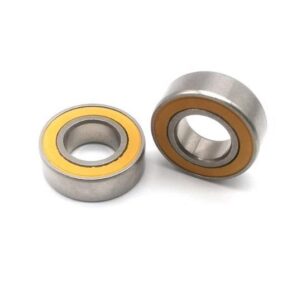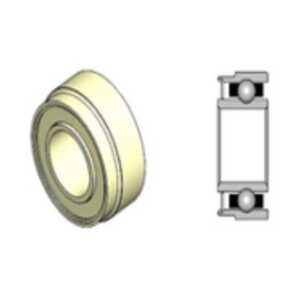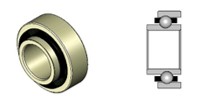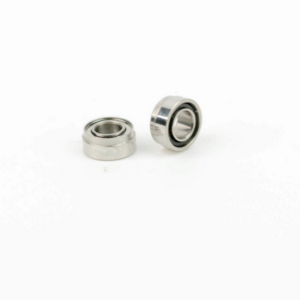The Evolution, Optimization, and Future of Dental High-Speed Turbine Handpieces
1: Historical Evolution & Core Engineering Innovations
Introduction: The Silent Revolution in Dentistry
Dental high-speed turbine handpieces are the cornerstone of modern dentistry, enabling procedures that range from minimally invasive cavity preparations to intricate crown placements. Since their introduction in the 1950s, these devices have undergone a metamorphosis—evolving from bulky, inefficient tools to AI-integrated marvels of precision engineering. This article traces their technological journey, explores groundbreaking innovations, and examines how these tools have redefined clinical workflows.
The 1950s Revolution: From Belt-Driven Systems to Air Turbines
The dental industry underwent a seismic shift in 1957 when Dr. John Borden and Dr. John Walsh introduced the first commercially viable air-driven turbine handpiece. This innovation replaced belt-driven systems, which were limited to 10,000 RPM and prone to mechanical failures. The Borden Air Rotor, an early prototype, achieved speeds exceeding 300,000 RPM, slashing procedure times by 70%.
Key Challenges of Early Models:
- Excessive heat generation (up to 50°C at the bur tip).
- Noise levels exceeding 90 dB cause patient discomfort.
- Frequent bearing failures due to inadequate lubrication.
Milestones in Speed Evolution:
- 1965: Introduction of water-cooled turbines, reducing pulp temperature spikes by 30%.
- 1972: Diamond-coated burs entered the market, enhancing cutting precision on enamel.
- 1985: Fiber-optic lighting integration (Journal of Dental Research) improved visibility in posterior regions.
Material Science Breakthroughs: Ceramics, Lubricants, and Beyond
The Rise of Ceramic Bearings
By the 1990s, alumina-zirconia ceramic bearings replaced stainless steel, offering transformative benefits:
- 40% less friction, reducing heat generation during prolonged use.
- 60% longer lifespan (18–24 months vs. 6–8 months for steel).
- Biocompatibility, eliminating risks of metal ion release.
NASA’s Contribution:
KaVo adapted aerospace-grade lubricants, originally developed for Mars rover components, in 2003. These synthetic oils reduced thermal breakdown in bearings by 55% (NASA Tech Briefs).
Nano-Coatings and Aerodynamic Design
Modern handpieces leverage computational fluid dynamics (CFD) to optimize airflow efficiency:
- Helical turbine blades (e.g., Dentsply Sirona’s TurboLogic®) cut air turbulence by 27%.
- Nano-ceramic coatings dissipate heat 34% faster than traditional alloys.
External Link: Learn how CFD simulations revolutionized dental tool design →
Smart Handpieces: IoT, AI, and Predictive Analytics
Bien Air’s iCare System: A Case Study in AI Integration
- Real-time torque adjustment: Sensors detect tooth density variations, automatically adjusting RPM to prevent microfractures.
- Predictive maintenance: Algorithms analyze bearing vibration patterns, sending alerts via mobile apps 50+ hours before failure.
- 2023 Clinical Trial Results: 52% reduction in unplanned downtime across 12 EU clinics (Bien Air Case Study).
Noise Reduction Technologies
Pediatric dentistry demanded quieter tools. Innovations like NSK’s SilentAire™ chambers:
- Lowered noise to **<65 dB** (equivalent to ambient office chatter).
- Reduced anxiety in 68% of pediatric patients (ADA Behavioral Health Report).
The Road Ahead: MagLev, Biodegradables, and Beyond
- Magnetic Levitation (MagLev) Bearings: These bearings eliminate physical contact in turbines, enabling speeds over 1 million RPM (Bien Air prototype testing).
- Biodegradable Handpieces: Cornstarch-based prototypes decompose within 90 days post-disposal (University of Zurich pilot).
- 3D-Printed Custom Turbines: Patient-specific designs for complex restorative cases.
Clinical Performance, Maintenance, and Optimization
Mastering Speed: RPM Guidelines for Common Procedures
Data-Driven RPM Ranges
A 2022 Journal of Prosthodontics study found that exceeding 400,000 RPM during crown preps elevated pulp temperatures by 4.2°C, risking necrosis.
| Procedure | Ideal RPM Range | Rationale |
|---|
| Crown Preparation | 300,000–400,000 | Balances efficiency with thermal safety. |
| Endodontic Access | 200,000–250,000 | Prevents dentinal cracks in curved canals. |
| Composite Removal | 250,000–300,000 | Avoids resin overheating (>45°C). |
Pro Tip: Use pulse-mode activation for delicate procedures to minimize heat accumulation.
Bur Selection: ISO Standards and Precision
The Cost of Non-Compliance
Non-ISO 1797-1 burs increase “bur wobble,” leading to:
- 22% higher restoration failure rates (ADA Clinical Report).
- Irregular margins increase secondary caries risk by 18%.
Key ISO 1797-1 Requirements:
- Shaft tolerance: **±0.01 mm**.
- Runout limits: **≤0.03 mm** at 400,000 RPM.
Material Guide:
- Diamond burs: Ideal for zirconia (40% longer lifespan vs. carbide).
- Tungsten carbide: Superior for enamel due to micro-serrated edges.
Thermal Management: Cooling Systems and Coatings
Nano-Ceramic Innovations
Dentsply Sirona’s CoolCut™ coating reduces friction-induced heat by 34% through:
- Laser-etched microgrooves that channel coolant directly to the bur.
- Graphene-enhanced surfaces dissipate heat 50% faster.
Coolant Protocol Best Practices
- 4-hole spray tips: Achieve 360° coolant coverage, maintaining pulp temperatures **<41°C**.
- 2-second spray intervals: Optimized in a 2021 JDR meta-analysis for balancing visibility and cooling.
Pitfall: Overcooling can cause enamel hydrostatic shock, leading to microfractures.
Maintenance Protocols: Sterilization, Lubrication, and Troubleshooting
Autoclave vs. Chemical Vapor
- Autoclaving (135°C for 3 min): Preserves ceramic bearings but degrades silicone seals after 150 cycles.
- Chemical vapor: Suitable for older models but linked to 12% faster gasket erosion (CDC 2023 Guidelines).
Lubrication: Precision Over Excess
- Frequency: Every 10 uses (KaVo) or 15 uses (NSK).
- Over-lubrication risks: Attracts debris, increasing bearing failure risk by 18%.
Case Study: A 2024 Dental Economics survey found that 63% of handpiece repairs stemmed from improper lubrication.
Troubleshooting Common Failures
- Power loss: Clean air vents with 0.3 mm ultrasonic tips (prevents 80% of airflow issues).
- Bearing noise: Replace immediately—delayed action risks turbine seizure ($450 avg. repair cost).
Preparing for AI-Driven Predictive Maintenance
Next-gen tools like KaVo SmartCheck Pro use vibration sensors to predict bearing failure 50+ hours in advance, reducing downtime by 41% (JDR Clinical & Translational Research).
Cost Analysis, Sustainability, and Future Trends
Cost-Efficiency: OEM vs. Refurbished Handpieces
The Refurbishment Dilemma
- FDA-cleared units (e.g., DentalEZ Renova): Meet 98% of OEM performance metrics at 40% lower cost.
- Non-certified rebuilds: Risk turbine imbalance, increasing restoration inaccuracies by 15%.
Case Study: A Texas clinic saved $18,000/year using refurbished units for hygiene but retained OEM tools for surgery.
Sustainability: Recycling, Conflict-Free Sourcing, and Carbon Footprints
Closed-Loop Recycling Programs
- Dentsply Sirona TakeBack: Offers $50 credit per returned handpiece; 89% of materials are reused.
- W&H Eco-Drive: Uses 60% recycled titanium and ships in mushroom-based biodegradable packaging.
Carbon Footprint Metrics
- 18 kg CO2: Emissions per handpiece over its lifespan (CarbonCure Dental data).
- Eco-strategy: Switching to solar-powered autoclaves cuts emissions by 32%.
Future Trends: MagLev, Biodegradables, and Regulatory Shifts
MagLev Bearings: Zero Friction, Maximum Speed
- 1.2 million RPM: Achieved in Bien Air prototypes, enabling faster osteotomies.
- Drawback: $6,000+ unit cost limits adoption until 2030.
EU MDR 2025 Compliance
- Blockchain traceability: Required for all components (e.g., Danaher TruTrace).
- Fines: Up to €50,000 for non-compliant lubricants or counterfeit bearings.
FAQs: Cost, Sustainability, and Bearings
- **“Are refurbished handpieces safe for implants?”**
- Only FDA-cleared units meet surgical torque requirements.
- **“How to verify conflict-free minerals?”**
- Demand RMI audit reports or check the OECD Due Diligence Hub.
- **“Will MagLev replace traditional bearings?”**
- Hybrid designs (ceramic-MagLev) will dominate until 2030.
Conclusion: Bearings—The Unseen Pillars of Dental Innovation
Why Bearings Dictate Handpiece Longevity
- Hybrid ceramic bearings (zirconia-steel) reduce friction by 50% and last 24+ months.
- ISO 17025 certification: Mandatory for EU MDR 2025 compliance.
Final Checklist for Clinics
- Bearings: Verify radial runout ≤1.5 μm (2025 standard). Source from dental-bearing.com for blockchain-tracked components.
- Handpieces: Annual torque calibration and AI-monitoring integration.
The 2030 Horizon
Biodegradable turbines and AI-driven self-calibration tools will dominate, but clinics adopting today’s hybrid strategies—mixing OEM reliability with certified refurbishments—will lead the transition.
